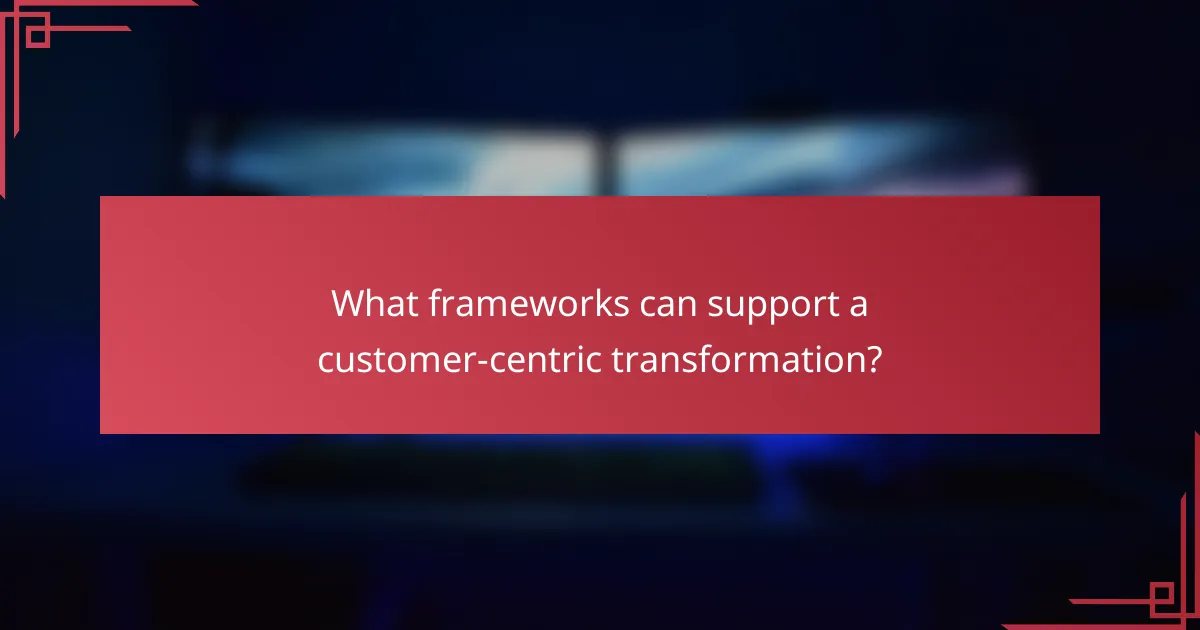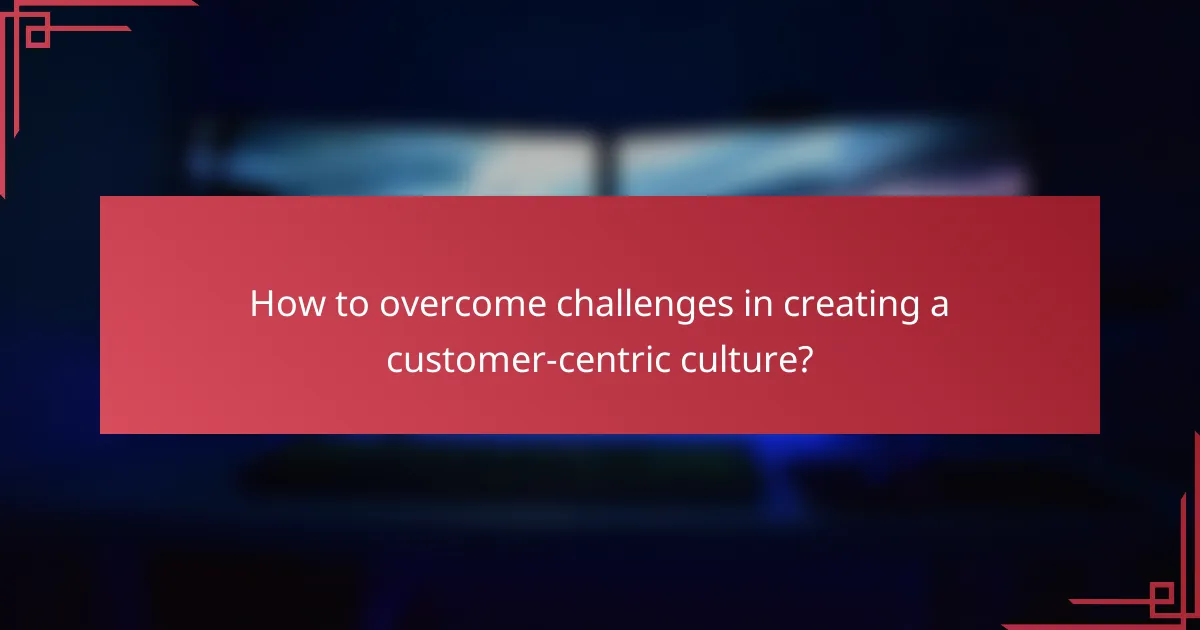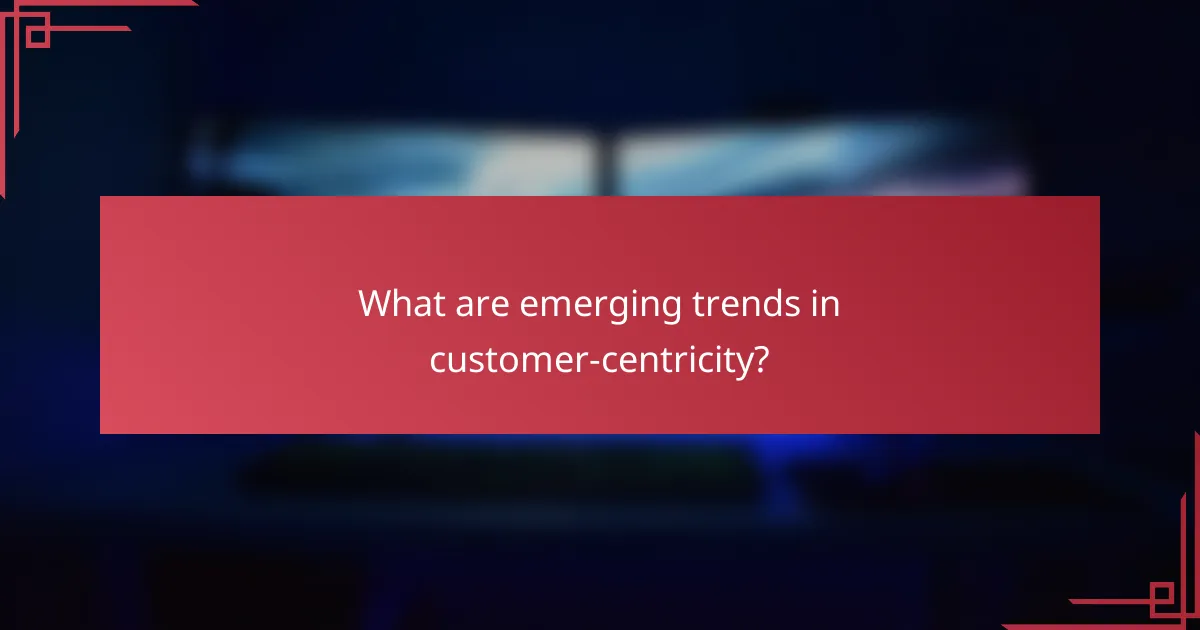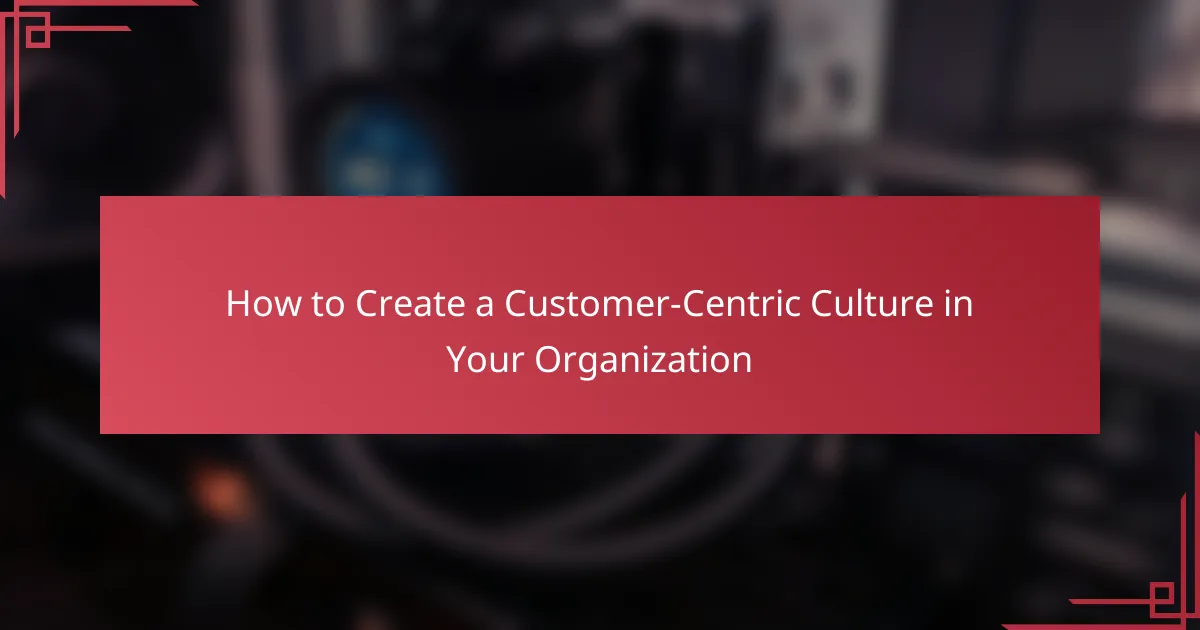Creating a customer-centric culture is essential for organizations aiming to enhance satisfaction and loyalty. By prioritizing customer needs in every aspect of operations, aligning company values, and engaging employees, businesses can foster an environment that values feedback and drives continuous improvement. Leadership plays a pivotal role in this transformation, setting the tone for a culture that prioritizes customer experiences and expectations.

How can organizations in the UK implement a customer-centric culture?
Organizations in the UK can implement a customer-centric culture by prioritizing customer needs in every aspect of their operations. This involves aligning company values, engaging employees, and actively seeking customer feedback to drive improvements.
Define customer-centric values
Defining customer-centric values is the foundation of a customer-focused culture. These values should emphasize empathy, responsiveness, and a commitment to quality service. For example, a company might adopt values like “customer first” or “excellence in service” to guide employee behavior.
Communicate these values clearly across the organization. This can be done through internal communications, training sessions, and visible reminders in the workplace, ensuring that every employee understands their role in delivering customer satisfaction.
Engage employees in training programs
Employee training programs are essential for fostering a customer-centric culture. These programs should focus on developing skills that enhance customer interactions, such as communication, problem-solving, and emotional intelligence. Regular workshops and role-playing scenarios can be effective methods for training.
Encourage participation by linking training to personal development goals and performance evaluations. This not only motivates employees but also reinforces the importance of customer service in their daily tasks.
Utilize customer feedback mechanisms
Implementing customer feedback mechanisms allows organizations to gather insights directly from their customers. Surveys, focus groups, and online reviews are effective tools for understanding customer experiences and expectations. Regularly analyze this feedback to identify trends and areas for improvement.
Make it easy for customers to provide feedback by offering multiple channels, such as email, social media, and dedicated feedback forms. Responding to feedback promptly can also enhance customer loyalty and show that their opinions are valued.
Integrate customer insights into decision-making
Integrating customer insights into decision-making processes ensures that the voice of the customer is considered at every level of the organization. This can involve using customer data to inform product development, marketing strategies, and service enhancements.
Establish cross-functional teams that include representatives from customer service, marketing, and product development to facilitate this integration. Regularly review customer insights during strategic planning sessions to align business objectives with customer needs.

What are the key benefits of a customer-centric culture?
A customer-centric culture focuses on prioritizing customer needs and preferences, leading to several significant benefits. Organizations that adopt this approach typically experience enhanced satisfaction, loyalty, and employee engagement, all of which contribute to long-term success.
Improved customer satisfaction
Improved customer satisfaction is a direct outcome of a customer-centric culture. When businesses actively listen to and address customer feedback, they can tailor their products and services to meet expectations more effectively. This responsiveness often results in higher satisfaction ratings and positive reviews.
To enhance customer satisfaction, companies should implement regular surveys and feedback mechanisms. For instance, using tools like Net Promoter Score (NPS) can help gauge customer sentiment and identify areas for improvement.
Increased customer loyalty
Increased customer loyalty stems from consistently positive experiences that a customer-centric culture fosters. When customers feel valued and understood, they are more likely to return and recommend the brand to others. This loyalty can translate into repeat business and a steady revenue stream.
To build loyalty, organizations can create personalized experiences, such as loyalty programs or tailored communications. Simple gestures, like remembering a customer’s name or preferences, can significantly enhance their connection to the brand.
Enhanced employee engagement
Enhanced employee engagement is another vital benefit of a customer-centric culture. When employees understand the importance of customer satisfaction and are empowered to contribute to it, they often feel more motivated and connected to their work. This engagement can lead to higher productivity and lower turnover rates.
To foster employee engagement, organizations should provide training on customer service best practices and encourage team collaboration. Recognizing and rewarding employees for their contributions to customer satisfaction can further strengthen their commitment to the company’s goals.

How can leadership drive a customer-centric approach?
Leadership plays a crucial role in fostering a customer-centric approach by setting the tone and expectations for the entire organization. By prioritizing customer needs and experiences, leaders can create a culture that values customer feedback and drives continuous improvement.
Model customer-centric behaviors
Leaders should exemplify customer-centric behaviors in their daily actions and decisions. This includes actively listening to customer feedback, addressing concerns promptly, and demonstrating empathy in interactions. When leaders prioritize customer satisfaction, it encourages employees to follow suit.
For example, a CEO who regularly engages with customers through surveys or social media can inspire a company-wide commitment to understanding customer needs. This modeling can significantly influence the organizational culture, making customer focus a shared value.
Communicate a clear vision
A clear vision of what a customer-centric culture looks like is essential for alignment across the organization. Leadership should articulate this vision through consistent messaging, emphasizing the importance of customer satisfaction and loyalty. This vision should be integrated into the company’s mission and values.
To reinforce this vision, leaders can share success stories that highlight the positive impact of customer-centric initiatives. Regular updates on customer satisfaction metrics can also keep the focus on the customer at all levels of the organization.
Empower teams to make customer-focused decisions
Empowering teams to make customer-focused decisions is vital for a responsive organization. Leaders should provide employees with the authority and resources to address customer issues quickly and effectively. This autonomy fosters a sense of ownership and accountability among team members.
To facilitate this empowerment, organizations can implement training programs that equip employees with the skills needed to understand customer needs and make informed decisions. Additionally, creating a feedback loop where employees can share customer insights with leadership can enhance the overall customer experience.

What frameworks can support a customer-centric transformation?
Several frameworks can effectively support a customer-centric transformation, focusing on understanding customer needs and enhancing their experience. Implementing these frameworks can lead to improved customer satisfaction and loyalty, ultimately benefiting the organization’s bottom line.
Customer Journey Mapping
Customer journey mapping is a visual representation of the steps customers take when interacting with your organization. This framework helps identify pain points and opportunities for improvement by outlining each touchpoint, from initial awareness to post-purchase support.
To create an effective customer journey map, gather data from customer feedback, surveys, and analytics. Involve cross-functional teams to ensure a comprehensive view of the customer experience. Regularly update the map to reflect changes in customer behavior or market conditions.
Net Promoter Score (NPS)
The Net Promoter Score (NPS) is a widely used metric for gauging customer loyalty and satisfaction. It measures the likelihood of customers recommending your organization to others, providing a clear indicator of overall customer sentiment.
To implement NPS, regularly survey customers with a simple question: “On a scale of 0 to 10, how likely are you to recommend us?” Analyze the results to categorize respondents into promoters, passives, and detractors. Use this feedback to drive improvements and address areas of concern.

What tools can help measure customer-centric success?
To measure customer-centric success, organizations can utilize various tools that provide insights into customer interactions and satisfaction. Key tools include Customer Relationship Management (CRM) systems and customer feedback platforms, which help track customer data and gather valuable feedback.
Customer Relationship Management (CRM) systems
CRM systems are essential for managing customer relationships and data throughout the customer lifecycle. They help businesses streamline processes, improve customer service, and enhance customer satisfaction by providing a centralized database of customer interactions.
When selecting a CRM, consider factors such as ease of use, integration capabilities, and scalability. Popular options include Salesforce, HubSpot, and Zoho, each offering various features tailored to different business needs.
Customer feedback platforms
Customer feedback platforms enable organizations to gather insights directly from customers regarding their experiences and satisfaction levels. These tools can include surveys, polls, and review systems that help identify areas for improvement.
When implementing feedback platforms, focus on asking clear, concise questions to obtain actionable insights. Tools like SurveyMonkey, Qualtrics, and Typeform can help you design effective surveys and analyze the results to drive customer-centric strategies.

How to overcome challenges in creating a customer-centric culture?
Overcoming challenges in creating a customer-centric culture requires a strategic approach that addresses resistance to change and ensures alignment across departments. By focusing on these areas, organizations can foster an environment that prioritizes customer needs and enhances overall satisfaction.
Address resistance to change
Resistance to change is a common barrier when shifting to a customer-centric culture. Employees may feel uncertain about new processes or fear losing their roles, which can lead to pushback. To combat this, it’s essential to communicate the benefits of a customer-centric approach clearly and involve employees in the transition process.
One effective strategy is to provide training sessions that highlight how a customer-centric culture can lead to improved job satisfaction and performance. Additionally, recognizing and rewarding employees who embrace the change can encourage others to follow suit.
Ensure alignment across departments
Alignment across departments is crucial for a successful customer-centric culture. When different teams work in silos, it can lead to inconsistent customer experiences and confusion. Establishing clear communication channels and shared goals can help unify efforts toward customer satisfaction.
Consider implementing regular cross-departmental meetings to discuss customer feedback and share best practices. Creating a centralized customer feedback system can also ensure that all departments have access to the same information, allowing for a more cohesive approach to addressing customer needs.

What are emerging trends in customer-centricity?
Emerging trends in customer-centricity focus on personalized experiences, data-driven decision-making, and enhanced customer engagement. Organizations are increasingly leveraging technology to understand customer preferences and tailor their offerings accordingly.
Personalization and Customization
Personalization involves tailoring products and services to meet individual customer needs. This can include customized marketing messages, product recommendations, and personalized customer service interactions. Companies that effectively implement personalization can see significant improvements in customer satisfaction and loyalty.
To achieve effective personalization, businesses should utilize customer data analytics to understand behavior patterns and preferences. Simple strategies include segmenting customers based on demographics or purchase history and crafting targeted campaigns that resonate with each group.
Data-Driven Decision Making
Data-driven decision-making is a critical trend in fostering customer-centricity. Organizations are increasingly relying on analytics to guide their strategies and improve customer experiences. By analyzing customer feedback, purchasing behavior, and market trends, companies can make informed decisions that align with customer expectations.
Implementing tools like customer relationship management (CRM) systems and data analytics platforms can help organizations gather and analyze relevant data. Regularly reviewing this data allows businesses to adapt their strategies and offerings to better meet customer needs.
Enhanced Customer Engagement
Enhanced customer engagement focuses on building strong relationships with customers through various channels. This includes social media interactions, email marketing, and loyalty programs that encourage ongoing communication and connection. Engaged customers are more likely to become brand advocates and contribute to positive word-of-mouth.
To enhance engagement, companies should actively seek customer feedback and respond promptly to inquiries and concerns. Utilizing platforms that facilitate two-way communication can foster a sense of community and loyalty among customers.



